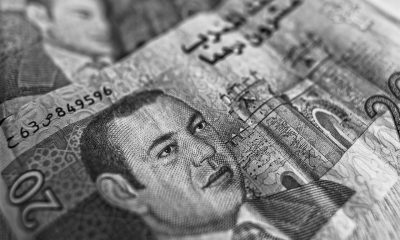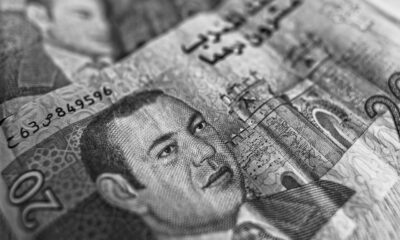Africa
The Bank Al-Maghrib’s liquidity deficit increases
Despite the slowdown recorded at the beginning of the year, the bank liquidity deficit should continue to grow in the medium term. A progression estimated by Bank Al-Maghrib on the basis of an expected increase in fiduciary money attenuated by the evolution of foreign exchange reserves.

According to Bank Al-Maghrib (BAM), the deficit should increase from $7.4 billion (67 billion dirhams) in 2020 to $9.34 billion (84.1 billion dirhams) at the end of 2021 and $10.3 billion (92.6 billion dirhams) at the end of 2022.
During the year 2020, the need for bank liquidity had increased to $10 billion (90.2 billion dirhams) on average weekly against $8.51 billion (76.6 billion dirhams) in 2019. A deepening carried by the increase in cash circulation, amounting to $4.88 million (44 MMDH) on average after $2.05 million (18.5 MMDH) a year earlier. The money supply in 2020 was marked by the strong growth of cash in circulation, which increased by $5.6 billion (50.4 billion dirhams) against $1.84 billion (16.6 billion dirhams) in 2019 and $1.58 billion (14.2 billion dirhams) on average over the past five years.
It was also marked by the expansion of $6.9 million (62.3 MMDH) in sight deposits, i.e. double the average rate since 2015. By main counterpart, the evolution of the money supply covers in particular decelerations from 22.3% to 19.3% for official reserve assets, from 25.8% to 22.4% for net claims on central government and from 5.3% to 4.7% for bank credit. To remedy this, the Central Bank increased its injection operations throughout the year before reducing its effort in the fourth quarter of 2020.
Read more about the Bank Al-Maghrib’s financial situation and find other important economic news with our companion app, Born2Invest.
Monetary conditions were also marked in 2020 by an annual decline in the average lending rate
Bank Al-Maghrib reduced the amount of its injections to $11.3 billion (101.9 billion dirhams), of which $4.52 billion (40.7 billion dirhams) in the form of 7-day advances, $2.76 billion (24.9 billion dirhams) through repurchase agreements, $3.38 billion (30.4 billion dirhams) in the form of guaranteed loans granted within the framework of programs to support the financing of SMEs and $644 million (5.8 billion dirhams) in the form of foreign exchange swap. At the same time, the banking liquidity deficit was mitigated by the evolution of BAM’s foreign exchange reserves, which rose to a weekly average of $3.24 million (29.2 MMDH) after $322,000 (2.9 MMDH) a year earlier.
Monetary conditions were also marked in 2020 by an annual decline in the average lending rate of 49 basis points, with in particular a drop of 119 points for SMEs, reflecting the reductions made in the total policy rate of 75 basis points, as well as an appreciation of the effective exchange rate. It should be said that, in this context, the Central Bank proceeded to the reduction of 75 basis points of the key interest rate, between March and June 2020, to bring it to 1.5%. In addition, the release of the account of the mandatory reserve for the benefit of banks, which has allowed to inject no less than 12 MMDH in the banking system and, thus, to relieve their treasuries, heavily impacted by measures related to the fight against the effects of the pandemic Covid-19. BAM has also put in place several measures to facilitate the financing of the economy and strengthen the capacity of the banking system to meet the needs of companies and households such as the postponement of loan maturities or the Damane Oxygen and Damane Relance products…. In this context, outstanding bank credit to the non-financial sector ended the year 2020 with an increase of 3.9% compared to 5.5% in 2019, supported by the support and stimulus measures put in place.
This very accommodating monetary policy has thus allowed the Central Bank to ensure adequate financing conditions, which is not to the liking of some professionals in the market. “The absence of inflationary pressures by 2022 offers Bank Al-Maghrib a comfortable margin of maneuver to further relax its monetary policy, in the event that the financing conditions of the economy prove to be insufficient,” argue analysts from Attijari Global Research. However, in terms of prospects, and taking into account the forecasts of economic growth and expectations of the banking system, it should increase by 3.6% in 2021 and 3.7% in 2022. Under these conditions, and taking into account the evolution of the other counterparts of the money supply, the growth of the M3 aggregate should slow down to 3.2% in 2021 before accelerating to 4.3% in 2022.
The real effective exchange rate is expected to depreciate over the forecast horizon, due to a lower level of domestic inflation than in partner and competitor countries. After appreciating by 0.8 percent in 2020, the real effective exchange rate should depreciate by 0.8 percent in 2021 and 0.6 percent in 2022.
__
(Featured image by geralt via Pixabay)
DISCLAIMER: This article was written by a third party contributor and does not reflect the opinion of Born2Invest, its management, staff or its associates. Please review our disclaimer for more information.
This article may include forward-looking statements. These forward-looking statements generally are identified by the words “believe,” “project,” “estimate,” “become,” “plan,” “will,” and similar expressions. These forward-looking statements involve known and unknown risks as well as uncertainties, including those discussed in the following cautionary statements and elsewhere in this article and on this site. Although the Company may believe that its expectations are based on reasonable assumptions, the actual results that the Company may achieve may differ materially from any forward-looking statements, which reflect the opinions of the management of the Company only as of the date hereof. Additionally, please make sure to read these important disclosures.
First published in LesEco.ma, a third-party contributor translated and adapted the article from the original. In case of discrepancy, the original will prevail.
Although we made reasonable efforts to provide accurate translations, some parts may be incorrect. Born2Invest assumes no responsibility for errors, omissions or ambiguities in the translations provided on this website. Any person or entity relying on translated content does so at their own risk. Born2Invest is not responsible for losses caused by such reliance on the accuracy or reliability of translated information. If you wish to report an error or inaccuracy in the translation, we encourage you to contact us.

-

 Biotech2 weeks ago
Biotech2 weeks agoDiscovery of ACBP Molecule Sheds Light on Fat-Burning Tissue Suppression and Metabolic Disease
-

 Impact Investing6 days ago
Impact Investing6 days agoFrance’s Nuclear Waste Dilemma Threatens Energy Future
-

 Markets2 weeks ago
Markets2 weeks agoGlobal Sugar Market Sees Mixed Trends Amid Weather Shifts and Price Pressures
-

 Fintech3 days ago
Fintech3 days agoKraken Launches Krak: A Game-Changing Peer-to-Peer Crypto Payment App

























